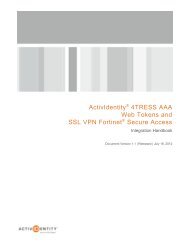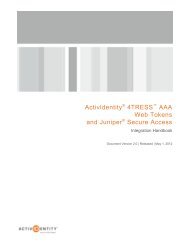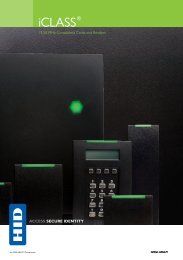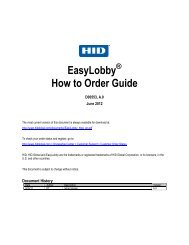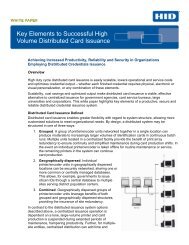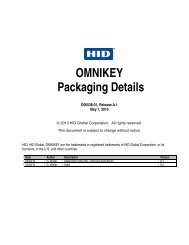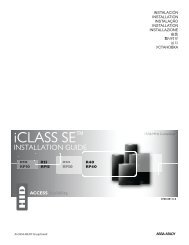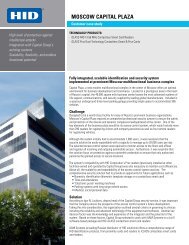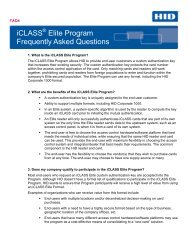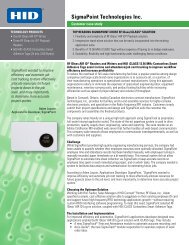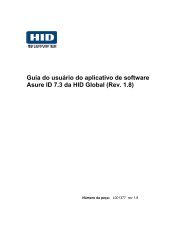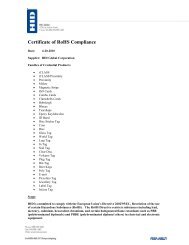Logical Access HTOG - HID Global
Logical Access HTOG - HID Global
Logical Access HTOG - HID Global
Create successful ePaper yourself
Turn your PDF publications into a flip-book with our unique Google optimized e-Paper software.
Anti-Counterfeiting Descriptions<br />
Printing Types<br />
<strong>Logical</strong> <strong>Access</strong> How to Order Guide – D00538, C.2<br />
1) Laminated Lithographic Printing: High resolution (>3600 dpi) offset printing technology yields photographic quality<br />
images. Laminated printing places the ink layer under a rigid clear plastic overlay which protects the printed image<br />
from abrasion and allows you to re-print over the existing artwork on the card. The cards are compatible with all Photo<br />
ID printing methods: dye-sub, reverse transfer and resin transfer.<br />
2) Surface Lithographic Printing: This process is identical to the Laminated Lithographic Printing, but the ink layer is<br />
applied to the outer surface of the finished card and may include a clear coat. You may not be able to re-print on the<br />
card. The inks and clear coat are not compatible with D2T2 printing (Dye Diffusion Thermal Transfer, AKA dyesublimation).<br />
The surface printing is durable enough for normal handling and use, but may wear more quickly in heavy<br />
use or swipe (magnetic stripe) applications. It is not recommended for high use applications, or for printing critical data<br />
such as emergency information. This process is often used for quick turnaround of simple text and graphics on card<br />
backs.<br />
Surface Hologram<br />
Holograms are one of the most recognizable anti-counterfeiting devices on the market. The optically variable image cannot be<br />
duplicated with standard printing. Surface holograms are applied via hot stamping to the exterior of the card surface. This style of<br />
application is common to all financial transaction cards.<br />
Embedded Hologram<br />
Embedded holograms are positioned under the rigid clear outer layer of the card surface. Unlike surface holograms, embedded<br />
holograms are amenable to dye sublimation – allowing the entire card surface to be personalized. This application style furthers<br />
the effectiveness of the anti-counterfeiting feature by requiring expensive specialized equipment during manufacture.<br />
Embedded Advantage Security Seal<br />
The Advantage product is a specialized optically variable device that is manufactured in only one plant worldwide. It has been<br />
the OVD of choice for many government identity documents, including many states driver licenses and the INS card. Like the<br />
embedded hologram, this device is placed under the rigid clear outer layer and is not subject to surface abrasion and wear.<br />
Advantage images shift from orange to green at different viewing angles.<br />
Invisible Ultra-Violet (UV) Fluorescing Images<br />
Common on credit card, currency and travel documents, invisible ink images provide a covert anti-counterfeiting mechanism.<br />
Though blue/violet fluorescing ink is readily available and inexpensive, red, green, yellow and orange fluorescing pigments<br />
remain difficult to acquire. This covert anti-counterfeiting device remains popular because of its relatively easy implementation in<br />
the field.<br />
Micro-fine Printing<br />
Very small spot color printing that exploits the limitations of inkjet, toner based (laser) and dye sublimation printers. Counterfeit<br />
reproductions can be determined with a handheld magnification tool.<br />
Guilloche Printing<br />
Fine line interlocking spot color patterns that are extremely difficult to scan and reproduce. These design elements are often<br />
multicolor and are commonly used on currency and travel documents.<br />
Composite Formulations<br />
Composite formulations are designed for durable applications and for use in dye sublimation printers that employ re-transfer<br />
technology and/or polyester laminate patches. Composite cards will minimize the warping caused by such processes. These<br />
formulations derive their strength from combining biaxial oriented polyester (OPET) with traditional polyvinyl chloride (PVC).<br />
October 2012 © 2010 - 2012 <strong>HID</strong> <strong>Global</strong> Corporation. All rights reserved. Page 33 of 37



